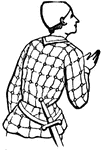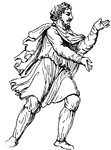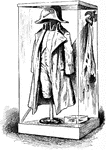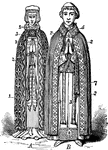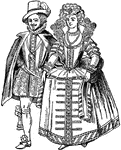The Complete Costumes ClipArt gallery offers 354 illustrations of men and women wearing outfits of various historical periods.

Man and Woman 18th Century Costumes
This is a Man and Woman dressed in 18th Century Costumes. The woman is dressed in a full dress that…

A Frankish Chief in Full Armor
A chief of a Frankish tribe, wearing full battle armor. He stands looking to his right holding a long…

A Roman Soldier, or Legionary, with a Short Javelin and Shield
Illustration of a Roman soldier, also called a legionary, carrying a shield, short sword, and a short…
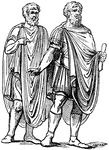
Abolla
A cloak chiefly worn by soldiers, and thus opposed to the toga, the garb of peace. The abolla was used…

Agrenon
"A net-like woolen garment worn by bachanals and soothsayers in ancient Greece. Image: Toso of Apollo…

Albe
"The long white linen vestment worn in early times by all ecclesiastics at divine service. It differed…

An English King from the 9th or 10th Century, Possibly King Alfred
Illustration of an English king between AD 800 and 1000. The king is very likely King Alfred who reigned…

Anglo-Saxon Female Costume from 10th Century England
A woman stands in several layers of clothing. The dress usually included a cloak, an overdress, an under-dress,…

Arbalister
"One armed with the arbalist; a crossbowman; especially, a soldier carrying the arbalist of war."-Whitney,…

Auger
"Among the anceient Romans, a functionary whose duty it was to observe and to interpret, according to…

Eagle Bearer
An eagle bearer from the Roman Empire. The eagle was made of precious metal and was the symbol of the…

Black Prince
"A contemporary portrait of the Black Prince when he was not armed, which consequently may be agreeably…

Late 19th Century Boy's Outfit
This Late 19th Century boy outfit is designed with a ruffled shirt and a beret hat that includes a ribbon.

Lady of Burgess Family
The illustration of a lady from the Burgess family. This shows how women of nobility would dress during…

Lady's Plaited Cape
This lady's plaited cape is a late 19th century design. It is trimmed with lace.

Cavalier
Cavalier was a name first used by Parliamentarians as a term of abuse for the wealthier male Royalist…

Cavalier
What a Cavalier wore. The name Cavalier originally related to political and social attitudes and behaviour,…

Cavalier
Example of the Cavalier style of clothing. The name Cavalier originally related to political and social…

Roman Centurion
A Centurio was a low-to-middle ranking officer in charge of a "century," ideally 100 men but ranging…

Chirodota
"A tunic with sleeves. The tunic of the Egyptians, Greeks and Romans was originally without sleeves,…
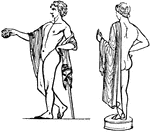
Chlamys
"A scarf, denoted an article of the amictus, or outer raiment of the Greeks. It was for the most part…

Roman Clypeus
"The following cut represents a Roman clypeus, from the column of Trajan. The projection in the centre…
Cope
"An ecclesiastical vestment, worn during the celebration of mass, at processions, vespers, and other…
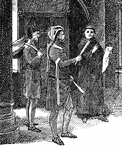
Juggler and Drummer Nursted Court
A drummer, juggler, and chaplain are entertaining the nobles and at Nursted Court. The kettle drum is…
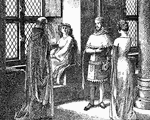
Nobles Talking Nursted Court
"The figure on the left is from a French manuscript picture, representing Merlin. The lady on the window—seat…




